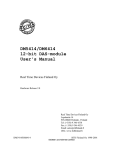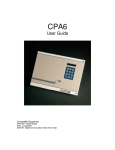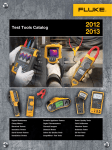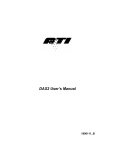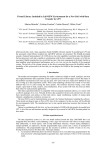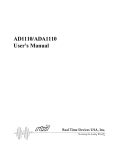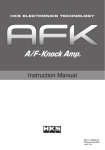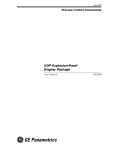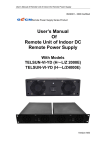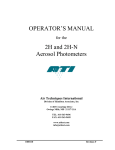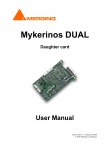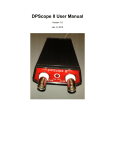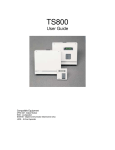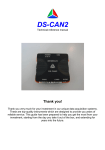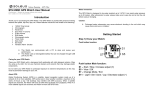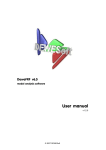Download DM5414/6414 User`s Manual - RTD Embedded Technologies, Inc.
Transcript
DM5414/6414 User's Manual 12-bit DAS PC/104 Module BDM-610010028 Rev. B ISO9001 and AS9100 Certified DM5414/6414 User's Manual RTD EMBEDDED TECHNOLOGIES, INC. 103 Innovation Blvd State College, PA 16803-0906 Phone: +1-814-234-8087 FAX: +1-814-234-5218 E-mail [email protected] [email protected] Web Site http://www.rtd.com Page 2 of 55 Manual Revision History Rev A Updated block diagrams, register descriptions, and solder blob table New manual naming method Rev B Changed picture of board. Published by: RTD Embedded Technologies, Inc. 103 Innovation Boulevard State College, PA 16803 Copyright 2005 by RTD Embedded Technologies, Inc. All rights reserved The RTD Embedded Technologies Logo is a registered trademark of RTD Embedded Technologies. dspModule, cpuModule, and utilityModule are trademarks of RTD Embedded Technologies. PC/104, PC/104-Plus, and PCI-104 are registered trademark of PC/104 Consortium. All other trademarks appearing in this document are the property of their respective owners. Page 3 of 55 Table of Contents Introduction...............................................................................................................................................7 Product Overview .................................................................................................................................7 Features ............................................................................................................................................7 Analog-to-Digital Conversion ........................................................................................................8 Digital-to-Analog Conversions.......................................................................................................8 8254 Timer/Counters.....................................................................................................................9 Digital I/O.......................................................................................................................................9 Mechanical Description ........................................................................................................................9 Connector Description ..........................................................................................................................9 Board Accessories................................................................................................................................9 Using this Manual .................................................................................................................................9 Getting Technical Support ..................................................................................................................10 Chapter 1 - Board Settings.....................................................................................................................11 Factory-Configured Jumper settings ...................................................................................................11 BA - Base Address (Factory Setting: 1A0h)................................................................................13 Clock Sources for Timer/Counters ..............................................................................................14 Chapter 2 - Board Installation ................................................................................................................25 Board Installation ............................................................................................................................25 External I/O Connections ................................................................................................................26 Primary 50 Pin Analog Digital Expansion Connector..................................................................26 Secondary 50 Pin Analog Digital Expansion Connector .............................................................28 Connecting the Analog Inputs.........................................................................................................29 Single ended ...............................................................................................................................29 Differential ...................................................................................................................................29 Connecting the Analog Outputs......................................................................................................30 Connecting the Timer/Counters and Digital I/O ..............................................................................30 Chapter 3 – Hardware Description.........................................................................................................31 A/D Conversion Circuitry ....................................................................................................................32 D/A Conversion Circuitry ....................................................................................................................32 Page 4 of 55 Timer/Counters ...................................................................................................................................33 Digital I/O, Advanced Bit Programmable Digital I/O ...........................................................................34 Chapter 4 – Board Operation and Programming ...................................................................................35 Defining the I/O Map...........................................................................................................................35 DM5414/6414 I/O Map Other Peripherals..........................................................................................37 BA+20 - DAS-chip Selection Register (Write).............................................................................37 BA+21 - DAC Control Register (Write)........................................................................................37 BA+21 - DAC Control Register (Read) .......................................................................................38 Overlay Bit = 0 ................................................................................................................................38 BA+24 – 8254 Timer/Counter 0 (Write/Read).............................................................................38 BA+25 – 8254 Timer/Counter 1 (Write/Read).............................................................................38 BA+26 – 8254 Timer/Counter 2 (Write/Read).............................................................................38 BA+27 – 8254 Control Word (Write) ...........................................................................................38 Overlay Bit = 1 ................................................................................................................................39 BA+24 – Digital I/O Port 0 (Write/Read) .....................................................................................39 BA+25 – Digital I/O Port 1 (Write/Read) .....................................................................................39 BA+26 – Port 0 Direction/Mask/Compare (Write/Read) .............................................................40 BA+27 - Direction Register (Bits 0-1 = 00)..................................................................................40 BA+27 - Mask Register (Bits 0-1 = 10) .......................................................................................40 BA+27 – Compare Register (Bits 0-1 = 10) ................................................................................40 BA+27 – Read Digital IRQ Status/Program Digital Mode (Write/Read) .....................................41 BA+28 – DAC channel 1 in selected chip, register low byte.......................................................42 BA+29 – DAC channel 1 in selected chip, register high byte .....................................................42 BA+2A – DAC channel 2 in selected chip, register low byte ......................................................42 BA+2B – DAC channel 2 in selected chip, register high byte .....................................................42 BA+2C – Board setup register #1 (Read) ...................................................................................43 BA+2D – Board setup register #2 (Read) ...................................................................................43 BA+2E – Digital I/O Register (Write/Read) .................................................................................43 Programming the DAS Chip ...............................................................................................................43 Programming the DM6414 .................................................................................................................44 Page 5 of 55 Clearing and setting bits in an I/O port........................................................................................44 A/D Conversions .........................................................................................................................45 Interrupts .....................................................................................................................................45 D/A Conversions .........................................................................................................................50 Timer/Counters............................................................................................................................50 Example Programs .............................................................................................................................52 DM5414/6414 Specifications .................................................................................................................53 Limited Warranty ....................................................................................................................................55 Page 6 of 55 Introduction Product Overview The DM6414 analog digital dataModule® will turn your PC/104 cpuModule™ or other PC/104 computer into a low power multifunction high performance data acquisition and control system. This user's manual describes the operation of the DM5414/DM6414 PC/104 Analog/Digital Interface board. Features Some of the key properties of the DM5414/DM6414 include: * 32 single ended or 16 differential analog input channels * 4 independent 12-bit low power A/D chips with 87 ksample/sec throughput * 0-2.5V or 0-5V input ranges * Each A/D chip features: Data acquisition sequencer 32 sample conversion FIFO 16-bit Data acquisition timer Window comparators Auto calibration * Software enabled interrupts * SYNC in and SYNC out for parallel sampling of up to 4 channels per board * 16 Digital I/O: 8 bit programmable direction, 8 port programmable direction * 16 Digital I/O: latched 8 Out, 8 in * Three 8254 based 16 bit Timer/Counters free for the user * Four 12-bit D/A channels with dedicated grounds * ±5V, ±10V, 0 − 5V, 0 − 10V Volt output ranges * Single +5V operation * Support for direct PC/104 interface with all RTD dataModules™ and front end boards. * PC/104 compliant form factor * DM5414 is XT bus, DM6414 is AT bus version * RTD IDAN frame compatible Page 7 of 55 The following paragraphs briefly describe the major features of the DM5414/6414. A more detailed discussion is included in Chapter 3 (Hardware description) and in Chapter 4 (Board operation and programming. The board setup is described in Chapter 1 (Board Settings). Analog-to-Digital Conversion The Analog-to-Digital circuitry consists of 4 independent 12-bit + sign integrated A/D-converters. These converters function independently of each other and can have different setups, acquisition speeds and input ranges. The analog input channels are divided between two 50-pin expansion connectors. Channels 1-16 are located on the "Primary" connector (J3) ; channels 17-32 are located on the "Secondary" connector (J4). The analog input channels are dedicated to the 4 A/D converter chips called DAS1, DAS2, DAS3, DAS4. DAS1 Channels 1-8 DAS2 Channels 9-16 DAS3 Channels 17-24 DAS4 Channels 25-32 Any two channels on one DAS chip can be configured for a differential input configuration. This means Channels 1 and 31 cannot work together in differential mode, but 1 and 5 can. The input voltage ranges 0-2.5V and 0-5V can be selected for each DAS-chip. This setup is done using "solder shorts" on the bottom side of the board (see Fig. 1-12). The 5V reference can be selected with jumpers from two sources: 1) A 5,0V absolute reference or 2) The analog 5V supply of the chip. Option 2 will provide ratiometric operation of the DAS-chips. The 5V source selection is global for all the DAS-chips (see Fig. 1-7). The onboard DAS-chips can be software programmed for different resolutions: These include: 9 or 12 bit + sign conversions. 9 bit conversions are much faster than 12 bit conversions. The maximum conversion time for 9 bits is 4.2µ s and for 13 bits 8.8µ s maximum. The typical throughput rate at 12 bits + sign is 87 ksample/sec. Conversions are controlled by the Data acquisitions sequencers on the DAS-chips. Each conversion can be configured independently and the sequencer program runs automatically sampling data into the onchip FIFO's with no CPU interference. Conversion parameters include window comparator monitoring, conversion resolution, acquisition delay etc. The features available for controlling each conversion in random order provide very powerful data acquisition performance. The converted data can be transferred to PC-memory in two ways. Data can be transferred using the programmed I/O mode or the interrupt mode. A special Interrupt mode using the REP INS (Repeat Input String) instruction supports very fast throughput rates. By generating an interrupt when the FIFO is half full, a REP INS instruction can be executed, transferring data to the PC memory and emptying the DAS FIFO at maximum rate allowed on the data bus. The mode of transfer is selected from software. Digital-to-Analog Conversions The Digital-to Analog (D/A) circuitry features four independent 12-bit analog output channels with jumper selectable output ranges of 0V to 5V, 0V to 10V, ± 5V, ±10V. Data is programmed into the D/A converter by writing two 8 bit bytes, the LSB and the MSB. The LSB contains the lower 8 data bits (0..7) and the MSB contains the higher data bits (8..11). The D/A converter latches can be loaded (updated) in parallel with a "Load" command. Page 8 of 55 8254 Timer/Counters One 8254 programmable Timer/Counter provides three independent 16-bit timer counters, to support a wide range of timing and counting functions. The source for the timer/counters can be the onboard clock (4 or 8 MHz jumper selectable) or an external oscillator. The timers T0 and T1 can be cascaded to generate a synchronizing signal to clock all the DAS-chips in parallel, or the output of these timers can be connected to an external IRQ-line. The 8254 timer/counter is not needed to set the acquisition speed of the DAS-chips since they have internal 16-bit timer counters to do this. Digital I/O The DM5414/6414 has 16 latched TTL/CMOS general purpose digital I/O available in the secondary expansion connector J4. These ports have 8 outputs in "port C "- lines and 8 inputs in "port A"- lines. The input port has onboard 47K pulldown resistors. These ports are not bit addressable. 16 buffered TTL/CMOS lines are also available grouped as eight independent, bit programmable lines in Port 0, and an 8-bit programmable port at Port 1. The bit-programmable lines support RTD's two Advanced Digital Interrupt modes. An interrupt flag can be set when any bit changes value (event interrupt) or when the lines match a programmed value (match interrupt). For either mode masking can be used to monitor selected lines. Port 0 is pulled low with 47K pulldown resistors. Mechanical Description The DM5414/6414 is designed on a PC/104 form factor. An easy mechanical interface to both PC/104 and EUROCARD systems can be achieved. Stack your PC/104 compatible computer directly on the DM5414 using the onboard mounting holes. DM5414 is XT bus, DM6414 is an AT bus board version. The DM5414/6414 also can be installed in the RTD IDAN modular aluminum enclosure system either in a single or double high frame. Connector Description There are two 50 pin analog/digital interface connectors on the DM5414/6414 to directly interface to I/O signals. The signal definition of these connectors is compatible with the analog- digital PC/104 dataModules™ manufactured by RTD. Board Accessories In addition to the items included in your DM5414/6414 delivery several software and hardware accessories are available. Call your distributor for more information on these accessories and for help in choosing the best items to support your instrumentation system. RTD can supply a complete set of accessories to your DM5414/DM6414 card. These include IDAN enclosures, power supplies, signal conditioning modules, terminal boards and other interconnection systems. Using this Manual This manual is intended to help you install your new DM5414/6414 card and get it running quickly, while also providing enough detail about the board and its functions so that you can enjoy maximum use of its features even in the most demanding applications. We assume you already have an understanding of basic data acquisition principles. Page 9 of 55 Getting Technical Support For help with this product, or any other product made by RTD, you can contact RTD Embedded Technologies via the following methods: Phone: +1-814-234-8087 E-Mail: [email protected] Be sure to check the RTD web site (http://www.rtd.com) frequently for product updates, including newer versions of the board manual and application software. Page 10 of 55 Chapter 1 - Board Settings The DM5414/6414 has jumper settings you can change to suit your application. The module is factoryconfigured as listed in the table and shown on the layout diagram in the beginning of this chapter. If you need to change the module settings, use these easy-to-follow instructions before you stack your module into your PC/104 system. Factory-Configured Jumper settings Table 1-1 lists the factory settings of the user configurable jumper settings on the DM5414/DM6414 board. Figures 1-1 and 1-2 show the board layout and the location of the factory-set jumpers. The following paragraphs explain how to change these settings. Pay special attention to the settings of the base address jumpers to avoid address contention when you first use your module in your system. Page 11 of 55 Table 1-1 Factory Settings Jumper Function Controlled (jmp#) Factory Settings (Jumpers Installed) BA Base Address (2) 1A0h (both not installed) TIMERS Clock source for counters (11) CNT0 OSC, CNT1 OT0, (Timers Cascaded) IRQ #1 Timer/Counter Interrupt (4) Disabled (Not selected) IRQ #2 DAS Interrupt (4) IRQ 5 IRQ #3 PPI Interrupt (4) Disabled (Not selected) B2, B14*, B17* DAS +5V REF source (1) Ratiometric (Connected to analog 5V, solder blob) DA1_R DA-chip 1 range select (2) Set to 10V range (J7) DA2_R DA-chip 2 range select (2) Set to 10V range (J8) DA3_R DA-chip 3 range select (2) Set to 10V range (J5) DA4_R DA-chip 4 range select (2) Set to 10V range (J6) DA1_P DA-channel 1 Bip/Unip (2) Set to bipolar range (J7) DA2_P DA-channel 2 Bip/Unip (2) Set to bipolar range (J8) DA3_P DA-channel 3 Bip/Unip (2) Set to bipolar range (J5) DA4_P DA-channel 4 Bip/Unip (2) Set to bipolar range (J6) B5 DAS1 REF 2.5/5.0 (3) Set to 2.5V (Solder connection bottom side) B3 DAS2 REF 2.5/5.0 (3) Set to 2.5V (Solder connection bottom side) B6 DAS3 REF 2.5/5.0 (3) Set to 2.5V (Solder connection bottom side) B1 DAS4 REF 2.5/5.0 (3) Set to 2.5V (Solder connection bottom side) B15*, B16* Analog 5V 5V Bus B9*, B10*, B11* Pullup/Pulldown DIO Pullldowns B4 IRQ Option PPI IRQ Status A TO D 4 or 8 MHz clock 4 Mhz (pins 2, 3) 8254 4 or 8 MHz clock 4 Mhz (pins 2, 3) Page 12 of 55 Fig 1-1 DM6414 Board Layout showing Factory-Configured settings (Future hardware revisions of this board may have cosmetic differences.) BA - Base Address (Factory Setting: 1A0h) The most common cause of failure when you are first setting up your module is address contention. Some of your computers I/O space is already occupied by other internal I/O devices and expansion boards. When the DM5414/6414 attempts to use it's reserved I/O addresses already used by another peripheral device, erratic performance may occur and data read from the board may be corrupted. To avoid this problem make sure you set up the base address first using the two jumpers which let you choose from 4 different I/O addresses in your computers I/O. Should the factory installed setting of 1A0h be unusable for your system configuration, you may change this setting to another using the options illustrated in Table 1-2. The table shows the switch settings and their corresponding values in hexadecimal values. Make sure you verify the correct location of the base address jumpers. Jumper #3 is Page 13 of 55 located below jumper #4 with the PC/104 bus connector toward the bottom. When the jumper is removed it corresponds to a logical "0", connecting the jumper to a "1". When you set the base address of the module, record the setting in the table inside the back cover of this manual after the Appendices. Table 1-2 Base Address Jumpers Address in HEX Address in Decimal Jumpers 1A0h 416d X3 = 0, X4 = 0 280h 640d X3 = 1, X4 = 0 300h 768d X3 = 0, X4 = 1 380h 896d X3 = 1, X4 = 1 0 = Jumper removed, 1 = Jumper closed Fig 1-2 Base Address Jumpers Clock Sources for Timer/Counters [Factory settings: CLK0-OSC, CLK1-OT0, CLK2-OT2] The jumpers shown in figure 1-3, let you select the clock sources for the 8254 based timer/counters, TC0, TC1, and TC2. The factory setting cascades all the three counter/timers, with the clock source for TC0 being the onboard clock (4 or 8 MHz jumper selectable), the output of TC0 providing the clock for TC1, and the output of TC1 providing the clock for TC2. You can connect TC0 and TC2 clock sources to an external clock through the "Primary" external I/O-expansion connector J3 or you can set TC0 and TC2 to be clocked by the onboard clock (4 or 8 MHz jumper selectable). Fig. 1-5 shows a block diagram of the counter/timer circuitry to help you with these connections. The SYNC jumper field connects the source for the SYNC pins of the AD converter chips. All the SYNC pins of the AD converters are connected together and selected with this jumper field Note: When installing jumpers on this header, make sure that only one jumper is installed in each group of the CLK pins. Page 14 of 55 Fig. 1-3 8254 Counter/Timer Clock Source Jumpers (Labels are not present on the board due to lack of space) Jumper Selectable 4 or 8 MHz Clock Page 15 of 55 Fig. 1-4 User Timer/Counter Circuit Diagram The header connectors shown in Figure 1-5, lets you connect the output of board interrupt sources to an interrupt channel. To activate a channel, you must install a jumper vertically across the desired IRQ channel's pins. To determine which DAS-chip has caused an interrupt and on what condition, you must read the interrupt status registers (BASE+14 and BASE+15) of each DAS chip with enabled interrupts. Reading these registers will clear all interrupt flags of the interrupt status register of the DAS-chip. All the 4 DASchips are connected together to one external interrupt request line with (positive) OR-logic. If any of the 4 chips has an active interrupt condition its interrupt request line will keep the global DAS-IRQ line active. This also means any of the chips may assert the interrupt request. If you have enabled interrupts on multiple chips, you must read the interrupt status registers of all the chips with enabled interrupts when a DAS- interrupt occurs. Failure to do so may keep the interrupt request line active (high) because one of the DAS chips may still have a pending (non-serviced) interrupt condition. Note: The IRQ lines are grouped as follows from left to right: IRQ11, IRQ10, IRQ7, IRQ5 Page 16 of 55 Fig. 1-5 Interrupt line factory setting DAS interrupt set at IRQ 5; other interrupts are disabled. REF DAS +5V Reference source selection (Factory settings: Ratiometric) The DAS chips 5V input voltage range can use two reference techniques: 1. Absolute reference, where a precision 5.00V reference is used at the Vref+ and GND to Vref2. Ratiometric reference, where the analog supply (5V) is connected to the Vref+ and GND to VrefIn ratiometric systems, the analog input voltage is proportional to the one used for the A/D converters reference voltage. When this is the system analog power supply, it relaxes the system reference requirements since the analog input voltage and the A/D - converter reference voltage change together. This maintains the same input code for the same conditions. Page 17 of 55 Fig. 1-6 – Solder Blob B2 This figure shows the 5V reference source selection solder blob B2. This setting is global for all the DAS-chips. The default setting for this solder blob is ratiometric. D/A - converter range select (Channels 1,2 and 3,4) DA1_R DA-chip 1 range select DA2_R DA-chip 2 range select DA3_R DA-chip 3 range select DA4_R DA-chip 4 range select DA1_R D/A-converter Range selection (Factory settings: 10V) DA2_R D/A-converter Range selection (Factory settings: 10V) The jumper field J7 configures D/A channel #1 while J8 configures channel #2. These jumper blocks are located next to the primary expansion connector J3. Figure 1-7 illustrates the range jumper for D/A - channels 1 and 2. Page 18 of 55 Fig. 1-7a Range Jumper for D/A Channels #1 and #2 set for 10V range Fig. 1-7b Range Jumper for D/A Channels #1 and #2 set for 5V range Page 19 of 55 DA3_R D/A-converter Range selection (Factory settings: 10V) DA4_R D/A-converter Range selection (Factory settings: 10V) The jumper field J5 configures D/A channel #3 while J6 configures channel #4. These jumper blocks are located next to the primary expansion connector J4. Figure 1-8 illustrates the range jumper for D/A - channels 3 and 4. Fig. 1-8a Range Jumper for D/A Channels #3 and #4 set for 10V range Fig. 1-8b Range Jumper for D/A Channels #3 and #4 set for 5V range Page 20 of 55 D/A - converter channel polarity select (Channels 1,2 and 3,4) DA1_P DA-channel 1 Bip/Unip DA2_P DA-channel 2 Bip/Unip DA3_P DA-channel 3 Bip/Unip DA4_P DA-channel 4 Bip/Unip DA1_P D/A-converter channel 1 Polarity selection (Factory setting: bipolar) DA2_P D/A-converter channel 2 Polarity selection (Factory setting: bipolar) The jumpers in jumper fields J7 and J8 select the polarity of the D/A converter channels 1 and 2. Available selections are unipolar or bipolar. For example if you have selected the range to be 10V and you set the polarity to bipolar you will achieve a -10V to +10V output range. Similarly if your range is set to 5V and you select unipolar you have a 0 to 5V output range. Fig. 1-9a Bipolar operation on D/A channels 1 and 2 Fig. 1-9b Unipolar operation on D/A channels 1 and 2 DA3_P D/A-converter channel 3 Polarity selection (Factory setting: bipolar) DA4_P D/A-converter channel 4 Polarity selection (Factory setting: bipolar) Page 21 of 55 The jumpers in jumper fields J5 and J6 select the polarity of the D/A converter channels 3 and 4. Available selections are unipolar or bipolar. For example if you have selected the range to be 10V and you set the polarity to bipolar you will achieve a -10V to +10V output range. Similarly if your range is set to 5V and you select unipolar you have a 0 to 5V output range. Fig. 1-10a Bipolar operation on D/A channels 3 and 4 Fig. 1-10b Unipolar operation on D/A channels 3 and 4 Page 22 of 55 B5 DAS1 Reference selection (Factory setting: 2.5V) B3 DAS2 Reference selection (Factory setting: 2.5V) B6 DAS3 Reference selection (Factory setting: 2.5V) B1 DAS4 Reference selection (Factory setting: 2.5V) The input range can be set individually for each DAS - chip. A three terminal solder jumper selects the range to be either 0 - 2.5V or 0 - 5.0V. These solder jumpers are located on the solder side (under side) of your DM5414/6414. They are grouped so that the range solder jumper is located approximately under each LM12458 DAS-chip. See figure 1-11 for detailed locations of these jumpers. Fig. 1-11a Location of DAS reference jumpers B1 and B6 Page 23 of 55 Fig. 1-11b Location of DAS reference jumpers B3 and B5 Page 24 of 55 Chapter 2 - Board Installation The DM5414/DM6414 is easy to install in your cpuModule™ of other PC/104 based system. This chapter tells you step-by-step how to connect your module into your stack. After you have made all of your connections, you can turn on your computer and run the diagnostic and test software to verify that your module is working. Board Installation Keep your board in its antistatic bag until you are ready to install it to your system! When removing it from the bag, hold the board at the edges and do not touch the components or connectors. Please handle the board in an antistatic environment and use a grounded workbench for testing and handling of your hardware. Before installing the board in your computer, check the jumper settings. Chapter 1 reviews the factory settings and how to change them. If you need to change any settings, refer to the appropriate instructions in Chapter 1. Note that incompatible jumper settings can result in unpredictable board operation and erratic response. General installation guidelines: 1. Turn OFF the power to your computer 2. Touch the grounded metal housing of your computer to discharge any antistatic buildup and then remove the board from its antistatic bag. 3. Select the appropriate standoffs for your application to secure the module when you install it in your system. 4. Holding the module by it's edges, orient it so that the PC/104 bus connector pin 1 lines up with pin 1 of the expansion connector onto which you are installing the module. 5. After carefully positioning the module so that the card edge connector is resting on the expansion connector, gently and evenly press down on the module until it is secured on the connector. Note: Do NOT force the module onto the connector. If the module does not slide into place remove it and try again. Wiggling the module or exerting too much pressure on the module can result in damage to the DM5414/6414 or other boards in the stack. 6. After the module is installed, connect the cable or cables to the analog expansion connectors J3 and J4. When making this connection, note that pin one is marked with a square on the top side of the board. For twisted pair cables, pin 1 is the dark brown wire; for standard 50 flat cables pin one is often marked in red. 7. Make sure all connections are secure. Page 25 of 55 External I/O Connections Primary 50 Pin Analog Digital Expansion Connector Figure 2-1 shows the DM5414/6414's J3 primary I/O connector pinout. Figure 2-2 shows the DM5414/6414's J4 secondary I/O connector pinout. Refer to these diagrams when you are making I/O connections. Note that +12V at pins #47 and -12V at pins #49 are only available if your system bus supplies these voltages. These voltages are not generated by the DM5414/6414. Page 26 of 55 Fig. 2-1 Primary Expansion Connector Pinout (J3) Note: AIN1 1 2 AIN9 AIN2 3 4 AIN10 AIN3 5 6 AIN11 AIN4 7 8 AIN12 AIN5 9 10 AIN13 AIN6 11 12 AIN14 AIN7 13 14 AIN15 AIN8 15 16 AIN16 AOUT1 17 18 AGND AOUT2 19 20 AGND AGND 21 22 AGND PA7 23 24 PC7 PA6 25 26 PC6 PA5 27 28 PC5 PA4 29 30 PC4 PA3 31 32 PC3 PA2 33 34 PC2 PA1 35 36 PC1 PA0 37 38 PC0 TRIGGER IN 39 40 DGND EXT GATE 1 41 42 T/C OUT 1 SYNC IN/OUT 43 44 T/C OUT 2 EXT CLOCK 45 46 EXT GATE 2 +12V (VCC) 47 48 +5V -12V (VSS) 49 50 DGND Digital I/O ports PC[0..7] are port programmable inputs or outputs and are derived from the advanced Digital Interface Chip. Port PA[0..7] is bit programmable and has Advanced Masking Modes. Please refer to the more detailed discussion on the functionality of the digital I/O in Chapter 3. Page 27 of 55 Secondary 50 Pin Analog Digital Expansion Connector Fig. 2-2 Primary Expansion Connector Pinout (J4) AIN17 1 2 AIN25 AIN18 3 4 AIN26 AIN19 5 6 AIN27 AIN20 7 8 AIN28 AIN21 9 10 AIN29 AIN22 11 12 AIN30 AIN23 13 14 AIN31 AIN24 15 16 AIN32 AOUT3 17 18 AGND AOUT4 19 20 AGND AGND 21 22 AGND IN7 23 24 OUT7 IN6 25 26 OUT6 IN5 27 28 OUT5 IN4 29 30 OUT4 IN3 31 32 OUT3 IN2 33 34 OUT2 IN1 35 36 OUT1 IN0 37 38 OUT0 EXT_SYNC IN 39 40 DGND EXT GATE 1 41 42 T/C OUT 1 SYNC IN/OUT 43 44 T/C OUT 2 EXT CLOCK 45 46 EXT GATE 2 +12V (VCC) 47 48 +5V -12V (VSS) 49 50 DGND Page 28 of 55 Connecting the Analog Inputs The analog inputs on this module can be set for single ended or differential operation. All channels can be configured to work in a differential mode, but only those channels that are grouped to one DAS chip can be differential i.e. channels 1-8, 9-16, 16-24 and channels 25-32. Single ended When the input channels are configured for single ended operation, connect the high side of the signal to one of the analog input channels, AIN1 - AIN32. Figure 2-3 shows how these connections are made. Fig. 2-3 – Single Ended Operation Differential When operating in this mode, your signal source may or may not have a separate ground reference. First connect the high side of the analog signal to the selected analog input channel of the channel group you are using (see above), and connect the low side of the signal to another analog input channel of the channel group you are using. Then, for signal sources with a separate ground reference, connect the ground from the signal source to one of the analog ground pins on the expansion connector you are using. Page 29 of 55 Fig. 2-4 – Differential Input Operation Connecting the Analog Outputs For each of the four analog outputs, connect the high side of the device receiving the output to the AOUT channel (J3-17, J3-19, J4-17, J4-19) and connect the low side of the device to an ANALOG GROUND (J3-18, J3-20, J4-18, J4-20). Connecting the Timer/Counters and Digital I/O For all these connections, the high side of the signals is connected to the appropriate signal pin on either the primary I/O connector J3 or the Secondary I/O connector J4. The low side of the signal shall be connected to any digital ground (GND). Page 30 of 55 Chapter 3 – Hardware Description This chapter describes the features of the DM5414/6414 hardware. The major circuits are the A/D-chips, the D/A converters, 8254-timer/counter, the digital I/O and the Advanced Bit Programmable Digital I/O. Figure 3-1 shows a general block diagram of the DM5414/6414. Page 31 of 55 Fig. 3-1 – DM5414 Block Diagram A/D Conversion Circuitry The DM5414/6414 can interface to 32 single ended or 16 differential input channels with a 0-2.5V or 05.0V input range. The conversion resolution and conversion rate are fully software configurable. The DM5414/6414 is designed using the highly integrated LM12458 low power DAS-chip. The A/D-chips are very flexible to program. Programming these chips is discussed in detail in Chapter 4, Module Operation and Programming. D/A Conversion Circuitry Four 12-bit analog outputs are included on the DM5414/6414. These four channels are grouped as follows: Channels 1 and 2 are located in the primary connector, Channels 3 and 4 are located in the secondary connector. Each of the channel pairs can have independent range settings. Each of the four channels can be set for bipolar or unipolar operation in the selected range. The 10 volt ranges have a resolution of 2.44 mV and the 5 volt range has a resolution of 1.22 mV. Page 32 of 55 Timer/Counters An 8254 programmable interval timer provides three 16-bit, timer/counters (4 or 8 MHz jumper selectable) to support a wide range of timing and counting functions. Two of the timer/counters TC0 and TC1, are cascaded so that they can be used for the pacer clock. The pacer clock is described in Chapter 4. Note, that each DAS-chip can use its internal counter as a pacer clock freeing counter/timers TC0 and TC1 for user applications. Timer TC2 is always free for the user. The timers have different options for clock sources as well as gate signals. Figure 3-2 shows the timer counter circuitry of the DM5414/6414. Fig. 3-2 User Timer/Counter Circuit Diagram Each Timer/Counter has two inputs, CLK in and GATE in, and one output, timer/counter OUT. They can be programmed as binary or BCD down counters by writing the appropriate data to the command word, as described in Chapter 4. The command word also lets you set up the different modes of operation. The six programmable modes are: Page 33 of 55 Mode 0 Event Counter (Interrupt on Terminal Count) Mode 1 Hardware-Retriggerable one-shot Mode 2 Rate Generator Mode 3 Square Wave Mode Mode 4 Software-Triggered Strobe Mode 5 Hardware Triggered Strobe (Retriggerable) Digital I/O, Advanced Bit Programmable Digital I/O Two separate digital I/O ports are available on the DM5414/6414. The primary digital I/O port consists of an 8-bit port programmable port and an 8-bit bit programmable port. Each bit can be programmed independently to be input or output in this port. All the bit programmable I/O lines are pulled down with a 10kohm resistor. The primary digital I/O port is located in the primary Analog Digital I/O expansion connector J3. The secondary general purpose digital I/O port has 8 latched TTL/CMOS compatible outputs and 8 TTL/CMOS compatible inputs with 10kohm pulldown resistors. The direction and configuration of the general purpose digital I/O-port is fixed to 8 outputs and 8 inputs. The secondary digital I/O port is located in the secondary Analog Digital I/O expansion connector J4. The internal Advanced Modes of the bit Programmable digital I/O port are discussed in detail in Chapter 4. Page 34 of 55 Chapter 4 – Board Operation and Programming This chapter explains the I/O map of the DM5414/6414 in detail and shows how to program the onboard peripherals such as the LM12458 DAS-chips, the 8254 Timer and the Digital I/O. Defining the I/O Map The I/O map of the DM5414/6414 is shown in Tables 4-1 and 4-2. As shown the board occupies 48 consecutive I/O addresses. To conserve the use of I/O space, the structure of the I/O map is such that some of the registers control what peripherals are accessed in other addresses. The control registers at addresses BA+20 and BA+21 select the active DAS- or D/A-chips and select either the 8254 timer of the Advanced Bit Programmable Digital I/O-chip. These functions can easily be understood by reviewing the following pages. The Base Address (designated as BA) can be selected by the two base address jumpers as described in Chapter 1, Module Settings. These jumpers can be changed without removing the module from the PC/104 stack. The following sections describe the register contents of each address used in the I/O map. Table 4-2 shows the I/O address locations for each DAS chip. The active DAS chip is selected with the DAS selection register located in address BA+20. Table 4-1 DM5414/6414 I/O Map - Other Peripherals Address Description #1 Description #2 BA+20 Write only DAS-chip selection register BA+21 Read/Write Read - Load DACs; Write – DAC chip select, Overlay bit BA+22 Reserved Reserved BA+23 Write Software trigger BA+24 Read/Write 8254 Timer/Counter 0 BA+25 Read/Write 8254 Timer/Counter 1 BA+26 Read/Write 8254 Timer/Counter 2 BA+27 Write only 8254 Control byte Overlay = 0 Overlay = 1 Page 35 of 55 BA+24 Read/Write Port 0 Data register BA+25 Read/Write Port 1 Data register BA+26 Read/Write Port 0 Control byte BA+27 Write only Digital I/O-chip Control byte BA+28 Write only DAC #1 Register low byte BA+29 Write only DAC #1 Register high byte BA+2A Write only DAC #2 Register low byte BA+2B Write only DAC #2 Register high byte BA+2C Read only Board setup register #1 BA+2D Read only Board setup register #2 BA+2E Read/Write Digital I/O (Connector J4) BA+2F Reserved Reserved BA = Base Address; Overlay bit is bit 2 in address BA+21 BA+0 RAM Pointer 00 (Program) Sequencer Instruction #0 BA+1… -“- Parameter field for Instruction #0 BA+E -“- Sequencer Instruction #15 BA+F -“- Parameter field for Instruction #15 BA+0 RAM Pointer 01 (Cmp. low limit) Comparison low limit #0 BA+1… -“- Polarity of Cmp. intr/sign of low limit #0 BA+E -“- Comparison low limit #15 BA+F -“- Polarity of Cmp. intr/sign of low limit #15 BA+0 RAM Pointer 10 (Cmp. high limit) Comparison high limit #0 BA+1… -“- Polarity of Cmp. intr/sign of high limit #0 BA+E -“- Comparison high limit #15 BA+F -“- Polarity of Cmp. intr/sign of high limit #15 Page 36 of 55 BA+10 Read/Write DAS Configuration Register #1 BA+11 Read/Write DAS Configuration Register #2 BA+12 Read/Write DAS Interrupt Enable Register #1 BA+13 Read/Write DAS Interrupt Enable Register #2 BA+14 Read/Write DAS Interrupt Status Register #1 BA+15 Read/Write DAS Interrupt Status Register #2 BA+16 Read/Write DAS Acquisition Timer Register #1 BA+17 Read/Write DAS Acquisition Timer Register #2 BA+18 Read/Write DAS Conversion FIFO low byte BA+19 Read/Write DAS Conversion FIFO high byte BA+1A Read/Write DAS low Limit Status Register BA+1B Read/Write DAS high Limit Status Register Identical I/O addressing for each DAS-chip, Chip selected in cnf. register BA+20 DM5414/6414 I/O Map Other Peripherals BA+20 - DAS-chip Selection Register (Write) This register controls which DAS chip is mapped to BA+0 to BA+F. Write a value of ‘1’ to a bit to select the given DAS-chip. Bit 3 DAS3 Note: Bit 2 DAS2 Bit 1 DAS1 Bit 0 DAS0 While it is possible to activate more than one DAS chip at a time, this behavior is undefined and not recommended. BA+21 - DAC Control Register (Write) Bits 0 and 1 of this register are used to select the active DAC. Both DACs can be active at the same time. Bit 2 of this register controls the Overlay bit. When the Overlay bit is ‘1’, the digital I/O will be mapped to BA+24 through BA+27. When the Overlay bit is ‘0’, the 8254 Timer/Counter will be mapped to BA+24 through BA+27. Bit 2 Overlay Bit 1 DAC1 Page 37 of 55 Bit 0 DAC0 BA+21 - DAC Control Register (Read) Performing a read from this address will load the D/A converters with the output data written to the D/A output registers. The individual bits of this register are undefined during reads. Overlay Bit = 0 BA+24 – 8254 Timer/Counter 0 (Write/Read) A read to this address shows the current contents of the timer T0. A write to this address reloads a new value to the timer. Counting begins as soon as the timer has bee loaded. This timer is cascaded with timer T1 to form the 32-bit pacer clock on the DM5414/6414. BA+25 – 8254 Timer/Counter 1 (Write/Read) A read to this address shows the current contents of the timer T1. A write to this address reloads a new value to the timer. Counting begins as soon as the timer has bee loaded. This timer is cascaded with timer T0 to form the 32-bit pacer clock on the DM5414/6414. BA+26 – 8254 Timer/Counter 2 (Write/Read) A read to this address shows the current contents of the timer T3. A write to this address reloads a new value to the timer. Counting begins as soon as the timer has been loaded. This timer is cascaded with timer T0 and T1 or used independently. The output of this timer may be connected to the external trigger input of the DM5414/6414. BA+27 – 8254 Control Word (Write) Bit 7 Bit 6 Counter Select Bit 5 Bit 4 Read/Load Bit 3 Counter select (Bits [7..6]): 00 – Counter 0 01 – Counter 1 10 – Counter 2 11 – Read Back Read/Load (Bits [5..4]): 00 – Latching 01 – RD/LD LSB only 10 – RD/LD MSB only 11 – RD/LD LSB+MSB Page 38 of 55 Bit 2 Bit 1 Counter Mode Bit 0 BCD/BIN Counter Mode (Bits [3..1]): 000 – Mode 0, event count 001 – Mode 1, programmable 1-shot 010 – Mode 2, rate generator 011 – Mode 3, square wave rate generator 100 – Mode 4, software triggered strobe 101 – Mode 5, hardware triggered strobe BCD/BIN Select (Bit 0) 0 – Binary 1 – BCD Overlay Bit = 1 BA+24 – Digital I/O Port 0 (Write/Read) This port transfers the 8-bit port 0 bit programmable digital I/O data between the board and external devices. The bits are individually programmable as inputs or outputs by writing to the Direction Control Register at BA+26. For all bits set as inputs, a read reads the input values and a write operation is ignored. For all the bits set as outputs, a read will return the last value written to the outputs and a write sends the value out. Bit 7 P0.7 Note: Bit 6 P0.6 Bit 5 P0.5 Bit 4 P0.4 Bit 3 P0.3 Bit 2 P0.2 Bit 1 P0.1 Bit 0 P0.0 After a board reset all lines are set to inputs and their corresponding output registers are cleared! BA+25 – Digital I/O Port 1 (Write/Read) This port transfers the 8-bit port 1 bit programmable digital I/O data between the board and external devices. The bits are individually programmable as inputs or outputs by writing to the Direction Control Register at BA+26. For all bits set as inputs, a read reads the input values and a write operation is ignored. For all the bits set as outputs, a read will return the last value written to the outputs and a write sends the value out. Bit 7 I/O.7 Note: Bit 6 I/O.6 Bit 5 I/O.5 Bit 4 I/O.4 Bit 3 I/O.3 Bit 2 I/O.2 Bit 1 I/O.1 Bit 0 I/O.0 After a board reset all lines are set to inputs and their corresponding output registers are cleared! Page 39 of 55 BA+26 – Port 0 Direction/Mask/Compare (Write/Read) Bit 7 Don’t Care Bit 6 Don’t Care Bit 5 Don’t Care Bit 4 Don’t Care Bit 3 Don’t Care Bit 2 Don’t Care Bit 1 Don’t Care Bit 0 Don’t Care Bit 3 P0.3 Bit 2 P0.2 Bit 1 P0.1 Bit 0 P0.0 Bit 3 P0.3 Bit 2 P0.2 Bit 1 P0.1 Bit 0 P0.0 BA+27 - Direction Register (Bits 0-1 = 00) A ‘0’ indicates an input, and a ‘1’ indicates an output. Bit 7 P0.7 Bit 6 P0.6 Bit 5 P0.5 Bit 4 P0.4 BA+27 - Mask Register (Bits 0-1 = 10) A ‘0’ indicates an input, and a ‘1’ indicates an output. Bit 7 P0.7 Bit 6 P0.6 Bit 5 P0.5 Bit 4 P0.4 In the Advanced Interrupt modes, this register is used to mask out specific bits when monitoring the bit pattern present at port 0 for interrupt generation. In normal operation where the Advanced Interrupt feature is not being used, any bit which is masked by writing ‘1’ to that bit will not change state regardless of the data written to port 0. For example, if you set the state of the bit 0 low and then mask this bit, the state will remain low regardless of what you output at port 0. (An output of 1 will not change the state of the output until the bit is unmasked.) BA+27 – Compare Register (Bits 0-1 = 10) This register is used for the Advanced Digital Interrupt modes. In the match mode where an interrupt is generated when the port 0 bits match a preloaded value, this register is used to load the bit pattern to be matched at port 0. Bits can be selectively masked so that they are ignored when making the match. Note: Make sure that bit 3 in BA+27 is set to 1, selecting match mode, BEFORE writing to the Compare Register value at this address. In the event mode where an interrupt is generated when any port 0 bit changes its current state, the value which caused the interrupt is latched at this register and can be read from it. Bits can also be selectively masked using the Mask Register so a change of state is ignored on these lines in the event mode. Page 40 of 55 BA+27 – Read Digital IRQ Status/Program Digital Mode (Write/Read) A read shows you whether a digital interrupt has occurred (bit 6), whether a strobe has occurred (bit 7), and lets you review the current state of bits 0-5. Register Read Bit 0 BA+7 port 0 reg. select Bit 1 Bit 2 Port 1 direction Bit 3 Digital IRQ mode Bit 4 Digital IRQ enable Bit 5 Digital sample clock select Bit 6 Digital IRQ status (0 = no interrupt; 1 = dig. Interrupt) Bit 7 Strobe status (0 = no; 1 = yes) Register Write Bit 0 BA+27 port 0 reg. select 00 = clear mode; 01 = dir. register; Bit 1 10 = mask reg.; 11 = comp. reg. Bit 2 Port 1 dir. (0 = input; 1 = output) Bit 3 Digital IRQ mode (0 = event mode; 1 = match mode) Bit 4 Digital IRQ enable (0 = disabled; 1 = enabled) Bit 5 Digital Sample CLK (0 = 8 MHz system clock; 1 = Programmable clock) Bit 6 Reserved bits Bit 7 Page 41 of 55 Bits 0 and 1 Select the clear mode initiated by the read or write operation at BA+26 or the port 0 control register you talk to at BA+27 (Direction, Mask, or Compare Register) Bit 2 Sets the direction of Port 1 digital lines Bit 3 Selects the digital interrupt mode: event (any Port 0 bits change state) or match (port 0 match the preprogrammed value in the Compare Register at address BA+27) Bit 4 Disables/Enable digital interrupts Bit 5 Sets the clock rate at which the digital lines are sampled when in the digital interrupt mode. Available clock source is the 4 MHz system clock. When a digital input line changes state, it must stay stable for two edges of the clock pulse before it's recognized and before an interrupt can be generated. This feature eliminated noise glitches that can cause a false state change on an interrupt line and cause an unwanted interrupt. Bit 6 Read only (digital IRQ status) Bit 7 Read only (digital strobe status) BA+28 – DAC channel 1 in selected chip, register low byte BA+29 – DAC channel 1 in selected chip, register high byte BA+2A – DAC channel 2 in selected chip, register low byte BA+2B – DAC channel 2 in selected chip, register high byte Writing to the register pairs will store the data into the currently enabled D/A channels selected in the address BA+21 bits 0 and 1. These bits enable the D/A converter chips as follows: BA+21 – DAC chip enable bit definitions Bit 1 Bit 0 D/A Channels Addressed 0 1 D/A converters are all disabled 0 1 Channels 1 & 2 in DAC chip 1 1 0 Channels 3 & 4 in DAC chip 2 1 1 Channels 1, 2, 3, and 4 in both chips Example: Write data to DAC channel 3. Step 1 - Enable DAC chip 2 by writing bit 1 to 1 and bit 0 to 0 Step 2 - Write low byte and high byte to BA + 29 and BA + 30 Step 3 - Load DAC storage registers to analog outputs by reading from BA+21. Note: Writing to storage registers will not update the outputs! Page 42 of 55 After the DAC storage registers are loaded you must perform a load to transfer the data to the outputs. This is performed by reading from BA+21. The read cycle will trigger the contents of the storage registers to the analog outputs. BA+2C – Board setup register #1 (Read) This register returns the status of the internal control bits of the register in BA+20 (DAS chip selection) the DM5414/6414. The bits that represent an active DAS chip will be set to ‘0’. Inactive DAS chips will have a value of ‘1’. This is the inverse of BA+20. Bit 3 DAS3 Bit 2 DAS2 Bit 1 DAS1 Bit 0 DAS0 BA+2D – Board setup register #2 (Read) This register returns the status of the internal control bits of the DM5414/6414; DAC selection bits and the overlay bit. Bit #3 is the interrupt status bit of the Advanced Digital I/O chip Bits [2..0] mirror register BA+21. Bits 1 and 0 are inverted. If the overlay bit is ‘1’, the digital I/O is selected. If the overlay bit is ‘0’, the timers are selected. If Bit 3 is ‘1’, the digital interrupt is pending. Bit 3 PPI_IRQ STAT Bit 2 OVERLAY Bit 1 DAC1 Bit 0 DAC0 BA+2E – Digital I/O Register (Write/Read) The DM5414/6414 features 16 general purpose digital I/O in two ports. One 8-bit output port and an 8bit input port. These ports are available at the secondary I/O connector J4. The pinouts are described in figure 2-4. The input port has 47K pulldown resistors connected to each input line. Write: Bit 7 OUT7 Bit 6 OUT6 Bit 5 OUT5 Bit 4 OUT4 Bit 3 OUT3 Bit 2 OUT2 Bit 1 OUT1 Bit 0 OUT0 Bit 7 IN7 Bit 6 IN6 Bit 5 IN5 Bit 4 IN4 Bit 3 IN3 Bit 2 IN2 Bit 1 IN1 Bit 0 IN0 Read: Programming the DAS Chip Programming the LM12458 is beyond the scope of this manual. Please refer to the LM12458 datasheet and application note AN-906 for programming details. They can be found at National Semiconductor’s website: http://www.national.com/ Note: Make sure you enable the correct chips for programming first by setting the DAS-enable bits in address BA+20. Page 43 of 55 Programming the DM6414 This section gives you some general information about programming the DM5414/6414 board, and then walks you through the major programming functions of the DM5414/6414. These descriptions will help you as you use the example programs and function libraries included with this board. All of the program descriptions use decimal values unless otherwise specified. The DM5414/6414 is programmed by writing to and reading from the correct I/O-port addresses of the board. These I/O ports were described in the previous section of this chapter. The following example shows how to perform a 8-bit read and write I/O port addresses using "C"-syntax and assembly code: Read: Write: “C”-syntax var = inp(address); outp(address,data); Assembly mov dx,address mov dx,address In ax,dx mov ax,data out dx,ax Note: 8-bit operations must be performed to the DM5414/6414 board to ensure correct operation. Clearing and setting bits in an I/O port When you clear or set bits in an I/O port you must be careful not to alter the status of other bits. You can preserve the status of all the bits you do not wish to change by proper use of the bitwise AND- and OR-operators. Using and or operators, single or multiple bits can easily be set or cleared in one line operations. 1. To clear a single bit in a port, AND the current value of the port with the value "B", where B = 255 - 2 (exp) bit. 2. To set a single bit in a port, OR the current value of the port with the value "B", where B = 2 (exp) bit. Bits are numbered from 0-7 for the low byte of a word and from 8-15 for the high byte of a word. Setting and clearing of multiple bits in a bye or word is more complex. 3. To clear multiple bits in a port, AND the current value of the port with the value "B", where B = 255 - (the sum of the values of the bits to be cleared). Note that the bits do not have to be consecutive. 4. To set multiple bits in a port, OR the current value of the port with the value "B", where B = (sum of the individual bits to be set). Page 44 of 55 A/D Conversions The A/D converter chip data acquisition sequencers must first be programmed to before A/D conversions can be made. Conversions can not be directly started from the host program with a single command. A/D conversions are performed by the DAS chips based on the data acquisition sequencer program. Conversion data is stored into the DAS chip internal FIFO, where it can be retrieved by the host. Before the DAS chips can be programmed they must be enabled by writing 1 to the correct DAS-enable bits of the register located in address BA+20. After this you may program the internal data acquisition sequencers to make conversions in the way you choose. Please refer to the component data- sheet for more specific details on the different options and modes of conversions. Interrupts What is an interrupt? An interrupt is an event that causes the processor in your computer to temporarily halt its current process and execute another routine. Upon completion of the new routine, control is returned to the original routine at the point where its execution was interrupted. Interrupts are a very flexible way of dealing with asynchronous events. Keyboard activity is a good example; your computer cannot predict when you might press a key and it would be a waste of processor time to do nothing while waiting for a keystroke to occur. Thus the interrupt scheme is used and the processor proceeds with other tasks. Then when a keystroke occurs, the keyboard 'interrupts' the processor , and the processor gets the keyboard data, placed it into memory, and then returns to what it was doing before the interrupt occurred. Other common devices that use interrupts are network cards, serial ports etc. Your DM5414/6414 can interrupt the main processor when a DAS-chip generates an interrupt or by the timer counter "Pacer clock". By using interrupts you can write powerful code to interface DM5414/6414 board Interrupt Request Lines To allow different peripheral devices to generate interrupts on the same computer, the PC AT bus has interrupt request channels (IRQs). A rising edge transition on one of these lines will be latched into the interrupt controller. The interrupt controller checks to see if the interrupts are to be acknowledged from that IRQ and, if another interrupt is being processed, it decides if the new request should supersede the one in progress or if it has to wait until the one in progress is done. The priority level of the interrupt is determined by the number of the IRQ; IRQ0 has the highest priority IRQ15 the lowest. Many of the IRQs are used by the standard system resources. IRQ0 is dedicated for the internal timer, IRQ1 is dedicated to the keyboard input, IRQ3 for serial port COM2 and IRQ4 for serial port COM1. Often interrupts 2,5 and 7 are free for the user. 8259 Programmable Interrupt Controller The chip responsible for handling interrupt requests in a PC is the 8259 Interrupt Controller. To use interrupts you will need to know how to read and set the 8259's internal interrupt mask register (IMR) and how to send the end-of-interrupt (EOI) command to acknowledge the 8259 interrupt controller. Interrupt Mask Register (IMR) Each bit in the interrupt mask register (IMR) contains the mask status of the interrupt line. If a bit is set (equal to 1), then the corresponding IRQ is masked, and it will not generate an interrupt. If a bit is cleared (equal to 0), then the corresponding IRQ is not masked, and it can generate an interrupt. The interrupt mask register is programmed through port 21h. Page 45 of 55 End-of-Interrupt (EOI) Command After an interrupt service routine is complete, the 8259 Interrupt Controller must be acknowledged by writing the value 20h to port 20h. What exactly happens when an interrupt occurs? Understanding the sequence of events when an interrupt is triggered is necessary to correctly write interrupt handlers. When an interrupt request line is driven high by a peripheral device (such as the DM5414/6414), the interrupt controller checks to see if interrupts are enabled for that IRQ, and then checks to see if other interrupts are active or requested and determines which interrupt has priority. The interrupt controller then interrupts the processor. The current code segment (CS), instruction pointer (IP), and flags are pushed onto the system stack, and a new set if CS and IP are loaded from the lowest 1024 bytes of memory. This table is referred to as the interrupt vector table and each entry to this table is called an interrupt vector. Once the new CS and IP are loaded from the interrupt vector table, the processor starts to execute code from the new Code Segment (CS) and from the new Instruction Pointer (IP). When the interrupt routine is completed the old CS and IP are popped from the system stack and the program execution continues from the point it was interrupted Using Interrupts in your Program Adding interrupt support to your program is not as difficult as it may seem especially when programming under DOS. The following discussion will cover programming under DOS. Note that even the smallest mistake in your interrupt program may cause the computer to hang up and will only restart after a reboot. This can be frustrating and time-consuming. Writing an Interrupt Service Routine (ISR) The first step in adding interrupts to your software is to write an interrupt service routine (ISR). This is the routine that will be executed automatically each time an interrupt request occurs for the specified IRQ. An ISR is different from other subroutines or procedures. First, on entrance the processor registers must be pushed onto the stack before anything else! Second, just before exiting the routine, you must clear the interrupts on the DM5414/6414 DAS chips, and write the EOI command to the interrupt controller. Finally, when exiting the interrupt routine the processor registers must be popped from the system stack and you must execute the IRET assembly instruction. This instruction pops the CS, IP and processor flags from the system stack. These were pushed onto the stack when entering the ISR. Most compilers allow you to identify a function as an interrupt type and will automatically add these instructions to your ISR with one exception: most compilers do not automatically add the EOI command to the function, you must do it yourself. Other than this and a few exceptions discussed below, you can write your ISR as any code routine. It can call other functions and procedures in your program and it can access global data. If you are writing your first ISR, we recommend you stick to the basics; just something that enables you to verify you have entered the ISR and executed it successfully. For example: set a flag in your ISR and in your main program check for the flag. Note: If you choose to write your ISR in in-line Assembly , you must push and pop registers correctly, and exit the routine with the IRET instruction instead of the RET instruction. There are a few precautions you must consider when writing ISRs. The most important is, do not use any DOS functions or functions that call DOS functions from an interrupt routine. DOS is not reentrant; that is, a DOS function cannot call itself. In typical programming, this will not happen because of the way DOS is written. But what about using interrupts? Then, you could have the situation such as this in your program. If DOS function X is being executed when an interrupt occurs and the interrupt Page 46 of 55 routine makes a call to the DOS function X, then function X is essentially being called while active. Such cases will cause the computer to crash. DOS does not support such operation. A general rule is, that do not call any functions that use the screen, read keyboard input and any file I/O routines should not be used in ISRs. The same problem of reentrancy exists for many floating point emulators as well, meaning you should avoid floating point mathematical operations in your ISR. Note, that the problem of reentrancy exists, no matter what programming language you use. Even, if you are writing your ISR in Assembly language, DOS and many floating point emulators are not reentrant. Of course, there are ways to avoid this problem, such as those which involve checking if any DOS functions are currently active when your ISR is called, but such solutions are beyond the scope of this manual. The second major concern when writing ISRs is to make them as short as possible in term of execution time. Spending long times in interrupt service routines may mean that other important interrupts are not serviced. Also, if you spend too long in your ISR, it may be called again before you have exited. This will lead to your computer hanging up and will require you to restart your computer. Your ISR should have the following structure: • Push any processor registers used in your ISR. Most C compiler do this automatically • Put the body of your routine here • Read interrupt status register of the DAS-chips on your DM5414/6414 board • Issue the EOI command to the 8259 by writing 20h to address 20h • Pop all registers. Most C compilers do this automatically Page 47 of 55 The following C example shows what the shell of your ISR should be like: /*-----------------------------------------------------------------------| Function: new_IRQ_handler | Inputs: Nothing | Returns: Nothing - Sets the interrupt flag for the EVENT. |-----------------------------------------------------------------------*/ void interrupt far new_IRQ_handler(void) { IRQ_flag = 1; // Indicate to main process interrupt has occurred { // Your program code should be here } // Read interrupt status registers that // clears interrupts in DAS chip NOTE: all active chips // must be read since all DAS interrupts are connected together outp(0x20, 0x20); /* Acknowledge the interrupt controller. */ } Saving the Startup Interrupt Mask Register (IMR) and Interrupt Vector The next step after writing the ISR is to save the startup state of the interrupt mask register (IMR) and the original interrupt vector you are using. The IMR is located in address 21h. The interrupt vector you will be using is located in the interrupt vector table which is an array of 4-byte pointers (addresses) and it is locate din the first 1024 bytes of the memory (Segment 0 offset 0). You can read this value directly, but it is a better practice to use DOS function 35h (get interrupt vector) to do this. Most C compilers have a special function available for doing this. The vectors for the hardware interrupts on the XT - bus are vectors 8-15., where IRQ0 uses vector 8 and IRQ7 uses vector 15. Thus if your DM5414/6414 is using IRQ5 it corresponds to vector number 13. Before you install your ISR, temporarily mask out the IRQ you will be using. This prevents the IRQ from requesting an interrupt while you are installing and initializing your ISR. To mask the IRQ, read the current IMR at I/O port 21h, and set the bit that corresponds to that IRQ. The IMR is arranged so that bit 0 is for IRQ0 and bit 7 is for IRQ7. See the paragraph entitled Interrupt Mask Register (IMR) earlier in this discussion for help in determining your IRQ's bit. After setting the bit, write the new value to I/O port 21h. With the startup IMR saved and the interrupts temporarily disabled, you can assign the interrupt vector to point to your ISR. Again you can overwrite the appropriate entry in the vector table with a direct memory write, but this is not recommended. Instead use the DOS function 25h (Set Interrupt Vector) or, if your compiler provides it, the library routine for setting up interrupt vectors. Remember, that interrupt vector 8 corresponds to IRQ0, vector 9 for IRQ1 etc. If you need to program the source of your interrupts, do that next. For example, if you are using Page 48 of 55 transmitted or received messages as an interrupt source, program it to do that. Finally, clear the mask bit for your IRQ in the IMR. This will enable your IRQ. Common Interrupt Mistakes • Remember, hardware interrupts are from 8-15, XT IRQ's are numbered 0-7 • Forgetting to clear the IRQ mask bit in the IMR • Forgetting to send the EOI command after ISR code. Disables further interrupts. Example on Interrupt Vector Table Setup in C-code: void far _interrupt new_IRQ1_handler(void ); #define IRQ1_VECTOR 3 /* ISR function prototype */ /* Name for IRQ */ void (interrupt far *old_IRQ1_dispatcher) (es,ds,di,si,bp,sp,bx,dx,cx,ax,ip,cs,flags); /* Variable to store old IRQ_Vector */ void far _interrupt new_IRQ1_handler(void ); /*---------------------------------------------------------------------| Function: init_irq_handlers | Inputs: Nothing | Purpose: Set the pointers in the interrupt table to point to | our funtions ie. setup for ISR's. |----------------------------------------------------------------------*/ void init_irq_handlers(void) { _disable(); old_IRQ1_handler = _dos_getvect(IRQ1_VECTOR + 8); _dos_setvect(IRQ1_VECTOR + 8, new_IRQ1_handler); Gi_old_mask = inp(0x21); outp(0x21,Gi_old_mask & ~(1 << IRQ1_VECTOR)); _enable(); } Page 49 of 55 D/A Conversions Two individual D/A converter chips with two channels each can be programmed to convert 12-bit digital words to an analog output voltage. To write to the D/A channels you must first enable the D/A converter chip by setting the correct D/A selection bit in the D/A setup register located in address BA+21. After the D/A chip is selected you may write your 12-bit data to the appropriate D/A data storage register. Note that this register data will not appear at the outputs before you issue a "load" instruction. This is performed by reading from address BA+21. After this the data in the storage registers is transferred to the analog outputs. This feature enables simultaneous updating of all the analog output channels. Timer/Counters An 8254 programmable interval timer provides three 16-bit, 8 MHz timer/counters for timing and counting purposes such as frequency measurement, event counting, and interrupts. Two of the timers can be cascaded to generate the "pacer clock". The remaining timer/counter is available for other use. Figure 41 shows the timer counter circuitry. Each timer/counter has two inputs, CLK in and GATE in, and one output, timer/counter OUT. They can be programmed as either binary or BCD down counters by writing the appropriate data to the 8254 Control word as described in the I/O map description earlier in this chapter. One of the two clock sources, the onboard clock (4 or 8 MHz jumper selectable) or the external clock (J3 pin 45) can be selected as the clock input to TC0 or TC1. The diagram shows how these clock sources are connected to the timer/counters. Two gate sources are available at the I/O connector (J3 pin 41 and J3 pin 46). When the gate is disconnected an onboard pull-up resistor automatically pulls the gate high, enabling the timer/counters. The output from timer/counter 1 is available at the T/C 1 OUT pin (J3 pin 42) and the timer/counter 2's output is available at T/C 2 OUT (J3 pin 44), where they can be used for interrupt generation, DAS triggers or for other counting purposes. The timer/counters can be programmed to operate in one of six modes, depending on your application. The following section briefly describes each mode. Page 50 of 55 Fig. 4-2 User Timer/Counter Circuit Diagram Mode 0 - Event Counter This mode is typically used for event counting. While the timer/counter counts down, the output is low, and when the count is complete, it goes high. The output stays high until a new mode 0 control word is written to the timer/counter. Mode 1 - Hardware-Retriggerable One-Shot The output is initially high and goes low on the clock pulse following a trigger to begin the one-shot pulse. The output remains low until the count reaches 0, and then goes high and remains high until the clock pulse after the next trigger. Mode 2 - Rate Generator This mode functions like a divide-by-N counter and is typically used to generate a real-time-clock interrupt. The output is initially high, and when the count decrements to 1, the output goes low for one clock pulse. The output then goes high again, the counter reloads the initial count, and the process is repeated. This sequence continues indefinitely. Page 51 of 55 Mode 3 – Square Wave Mode Similar to mode 2 except for the duty cycle output, this mode is typically used for baud-rate generation. The output is initially high, and when the counter decrements to one half of its initial count the output goes low for the remainder of the count. The counter reloads and the output goes high again. This process repeats indefinitely. Mode 4 – Software Triggered Strobe The output is initially high. When the initial count expires, the output goes low for one clock pulse and then goes high again. Counting is triggered by writing the initial count. Mode 5 – Hardware Triggered Strobe The output is initially high. Counting is triggered by the rising edge of the gate signal. When the initial count has expired, the output goes low for one clock pulse and goes high again. Example Programs Drivers and example programs are provided on the CD-ROM shipped with the product. For the latest driver released, visit the RTD web site at http://www.rtd.com. Page 52 of 55 DM5414/6414 Specifications Host Interface • I/O mapped, occupies 32 bytes • Jumper-selectable base address, 4 options • 8-bit data bus, 16 bit PC/104 bus connector • Jumper selectable interrupts XT and AT Analog Interfaces • • 32 analog inputs (For full specification please consult component specific datasheet for the LM12458CIV A/D converter) o 8-12 bit resolution, programmable o 0 to 2,5V or 0- 5,0V input range o Single ended or differential operation o Interrupt support 4 analog outputs o 12 bit resolution o Simultaneously updated o 4 output ranges , channel by channel configurable o 0-5V, 0-10V, +-5V, +-10V Digital I/O • Number of lines 16+16 o 16 register configured 8 inputs 8 outputs o 8 bit programmable digital I/O lines o 8 port programmable digital I/O lines with advanced modes and Interrupt support Timers • Number of timers 3 (8254 compatible) o Clock sources include 4 or 8 MHz jumper selectable oscillator or external source o Counters can be cascaded o External gating o Interrupt support Page 53 of 55 Connectors • Analog /Digital I/O's - Header connectors 50-Pin • Host bus - AT PC/104 bus Electrical Specifications • Operating temperature range: -40º to +85ºC • Supply voltage: +5V only • Power consumption: 1.5W Page 54 of 55 Limited Warranty RTD Embedded Technologies, Inc. warrants the hardware and software products it manufactures and produces to be free from defects in materials and workmanship for one year following the date of shipment from RTD EMBEDDED TECHNOLOGIES, INC. This warranty is limited to the original purchaser of product and is not transferable. During the one year warranty period, RTD EMBEDDED TECHNOLOGIES will repair or replace, at its option, any defective products or parts at no additional charge, provided that the product is returned, shipping prepaid, to RTD EMBEDDED TECHNOLOGIES. All replaced parts and products become the property of RTD EMBEDDED TECHNOLOGIES. Before returning any product for repair, customers are required to contact the factory for an RMA number. THIS LIMITED WARRANTY DOES NOT EXTEND TO ANY PRODUCTS WHICH HAVE BEEN DAMAGED AS A RESULT OF ACCIDENT, MISUSE, ABUSE (such as: use of incorrect input voltages, improper or insufficient ventilation, failure to follow the operating instructions that are provided by RTD EMBEDDED TECHNOLOGIES, "acts of God" or other contingencies beyond the control of RTD EMBEDDED TECHNOLOGIES), OR AS A RESULT OF SERVICE OR MODIFICATION BY ANYONE OTHER THAN RTD EMBEDDED TECHNOLOGIES. EXCEPT AS EXPRESSLY SET FORTH ABOVE, NO OTHER WARRANTIES ARE EXPRESSED OR IMPLIED, INCLUDING, BUT NOT LIMITED TO, ANY IMPLIED WARRANTIES OF MERCHANTABILITY AND FITNESS FOR A PARTICULAR PURPOSE, AND RTD EMBEDDED TECHNOLOGIES EXPRESSLY DISCLAIMS ALL WARRANTIES NOT STATED HEREIN. ALL IMPLIED WARRANTIES, INCLUDING IMPLIED WARRANTIES FOR MECHANTABILITY AND FITNESS FOR A PARTICULAR PURPOSE, ARE LIMITED TO THE DURATION OF THIS WARRANTY. IN THE EVENT THE PRODUCT IS NOT FREE FROM DEFECTS AS WARRANTED ABOVE, THE PURCHASER'S SOLE REMEDY SHALL BE REPAIR OR REPLACEMENT AS PROVIDED ABOVE. UNDER NO CIRCUMSTANCES WILL RTD EMBEDDED TECHNOLOGIES BE LIABLE TO THE PURCHASER OR ANY USER FOR ANY DAMAGES, INCLUDING ANY INCIDENTAL OR CONSEQUENTIAL DAMAGES, EXPENSES, LOST PROFITS, LOST SAVINGS, OR OTHER DAMAGES ARISING OUT OF THE USE OR INABILITY TO USE THE PRODUCT. SOME STATES DO NOT ALLOW THE EXCLUSION OR LIMITATION OF INCIDENTAL OR CONSEQUENTIAL DAMAGES FOR CONSUMER PRODUCTS AND SOME STATES DO NOT ALLOW LIMITATIONS ON HOW LONG AN IMPLIED WARRANTY LASTS, SO THE ABOVE LIMITATIONS OR EXCLUSIONS MAY NOT APPLY TO YOU. THIS WARRANTY GIVES YOU SPECIFIC LEGAL RIGHTS, AND YOU MAY ALSO HAVE OTHER RIGHTS WHICH VARY FROM STATE TO STATE. Page 55 of 55























































